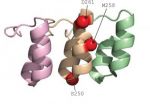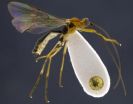(Press-News.org) ROSEMENT, Ill.─As participation in high-demand sports such as basketball and soccer has increased over the past decade, so has the number of anterior cruciate ligament (ACL) injuries in teens and young adults. In a study appearing today in the Journal of Bone and Joint Surgery (JBJS) (a research summary was presented at the 2014 Annual Meeting of the American Academy of Orthopaedic Surgeons in March), researchers found that universal neuromuscular training for high school and college-age athletes—which focuses on the optimal way to bend, jump, land and pivot the knee—is an effective and inexpensive way to avoid ACL sprains and tears.
The ACL is a critical ligament that stabilizes the knee joint. An ACL injury, one of the most common sports injuries affecting approximately 200,000 Americans each year, often requires surgery and a lengthy period of rehabilitation. Recent research has found that screening tools such as a "hop test" or isokinetic dynamometer which measure muscle strength to identify neuromuscular deficits, as well as neuromuscular training programs, may reduce ACL injuries.
Researchers evaluated three strategies for young athletes: no training or screening, universal neuromuscular training, and universal screening with neuromuscular training for identified high-risk athletes only. The research used a mathematical model for risk and screening based on published data on real student athletes, ages 14-22. Costs of training and screening programs were estimated based on existing literature. Anterior cruciate ligament surgical costs were estimated at between $5,000 and $17,000, with costs running as high as $38,000.
Among the findings:
On average, universal training reduced the incidence of ACL injury by 63 percent (from 3 to 1.1 percent per season), while the screening program, on average, reduced the incidence rate by 40 percent (from 3 to 1.8 percent).
Out of 10,000 athletes, the model predicted 300 ACL injuries in the no-screening group, 110 in the universal training group, and 180 in the universal training/screening for "at risk" athletes group.
Researchers estimated the cost of implementing a universal training program, including coach and player instruction, at approximately $1.25 per day, saving an average of $275 per player, per season in injury-related costs.
"Use of both preventative measures and screening tools sounds appealing, but often there are significant financial, administrative and social hurdles that have to be overcome before they can be implemented on a widespread level," said lead study author Eric F. Swart, MD, an orthopaedic resident at Columbia University Medical Center in New York.
"While we were not surprised that training was more cost-effective than no intervention, we were impressed at the magnitude of the benefit," said Dr. Swart. "According to our model, training was so much less expensive and so much more effective than we anticipated. In addition, fewer players injured mean fewer surgical reconstruction procedures, which also saves money. The research suggests that widely implementing a universal training strategy could actually pay for itself in terms of injuries prevented and surgeries avoided, which makes a very appealing case for primary prevention."
INFORMATION:
Study Details
In the study, an analytic model was created within the parameters of the U.S. Public Health Service's Panel on Cost Effectiveness in Health and Medicine. The reference case was a hypothetical cohort of athletes involved in organized sports, including male and female high school and college athletes between the ages of 14 and 22, who played soccer, handball, volleyball and basketball. Costs were calculated using the longest follow-up data available on patients with ACL injuries. Outcomes were expressed in quality-adjusted life years (QALYs), and take into account quality of life changes due to disease and/or injury as well as the time over which these changes occur. A discussion model, created and analyzed using decision-analysis software, compared multiple intervention strategies and predicted outcomes. The probabilities, costs and outcomes were assigned values, which provided average expected-value outcomes for each strategy.
AAOS on Facebook, Twitter and Google
Universal neuromuscular training an inexpensive, effective way to reduce
New study shows training could save $275 per athlete, per season in injury-related costs
2014-05-08
ELSE PRESS RELEASES FROM THIS DATE:
Collaboration between psychologists and physicians important to improving primary health care
2014-05-08
WASHINGTON - Primary care teams that include both psychologists and physicians would help address known barriers to improved primary health care, including missed diagnoses, a lack of attention to behavioral factors and limited patient access to needed care, according to health care experts writing in a special issue of American Psychologist, the flagship journal of the American Psychological Association.
"At the heart of the new primary care team is a partnership between a primary care clinician and a psychologist or other mental health professional. The team works together ...
Small mutation changes brain freeze to hot foot
2014-05-08
DURHAM, N.C. -- Ice cream lovers and hot tea drinkers with sensitive teeth could one day have a reason to celebrate a new finding from Duke University researchers. The scientists have found a very small change in a single protein that turns a cold-sensitive receptor into one that senses heat.
Understanding sensation and pain at this level could lead to more specific pain relievers that wouldn't affect the central nervous system, likely producing less severe side effects than existing medications, said Jörg Grandl, Ph.D., an assistant professor of neurobiology in Duke's ...
Statins given early decrease progression of kidney disease
2014-05-08
AURORA, Colo. (May 8, 2014) - Results from a study by University of Colorado School of Medicine researchers show that pravastatin, a medicine widely used for treatment of high cholesterol, also slows down the growth of kidney cysts in children and young adults with autosomal dominant polycystic kidney disease (ADPKD).
ADPKD is the most common potentially lethal hereditary kidney disease, affecting at least 1 in 1000 people. ADPKD is characterized by progressive kidney enlargement due to cyst growth, which results in loss of kidney function over time. At one time, ADPKD ...
Mummy-making wasps discovered in Ecuador
2014-05-08
Some Ecuadorian tribes were famous for making mummified shrunken heads from the remains of their conquered foes. Field work in the cloud forests of Ecuador by Professor Scott Shaw, University of Wyoming, Laramie, and colleagues, has resulted in the discovery of 24 new species of Aleiodes wasps that mummify caterpillars. The research by Eduardo Shimbori, Universidade Federal de São Carlos, Brazil, and Scott Shaw, was recently published in the open access journal ZooKeys.
Among the 24 new insect species described by Shimbori and Shaw, several were named after famous people ...
NASA sees system 91B lingering over southwestern India
2014-05-08
The tropical low pressure area known as System 91B has been making a slow northerly crawl while sitting inland in southwestern India, and NASA's Terra satellite captured a visible image of the struggling storm that showed half of it is over the Northern Indian Ocean.
NASA's Terra satellite passed over System 91B over southwestern India and the Moderate Resolution Imaging Spectroradiometer (MODIS) instrument captured a visible image on May 8 at 05:40 UTC/1:40 a.m. EDT. The despite having a poorly defined low-level circulation center on infrared imagery, the circulation ...
Experimental antibody shows early promise for treatment of childhood tumor
2014-05-08
Tumors shrank or disappeared and disease progression was temporarily halted in 15 children with advanced neuroblastoma enrolled in a safety study of an experimental antibody produced at St. Jude Children's Research Hospital. Four patients are still alive after more than two-and-a-half years and without additional treatment.
Findings from the Phase I study were published recently online and will appear in the May 10 edition of the Journal of Clinical Oncology. The results prompted St. Jude to expand clinical trials of the monoclonal antibody hu14.18K322A to include patients ...
Wake Forest Baptist finds success with novel lung cancer treatment
2014-05-08
WINSTON-SALEM, N.C. – May 8, 2014 – An old idea of retreating lung tumors with radiation is new again, especially with the technological advances seen in radiation oncology over the last decade.
The Comprehensive Cancer Center of Wake Forest Baptist Medical Center is one of only a handful of cancer centers that is attempting to give lung cancer patients out of treatment options a chance to keep the cancer at bay. For these patients, hope lies in a second course of treatment – repeat radiation. Two complementary papers published back-to-back recently in the journal Radiotherapy ...
Health screening for low-income women under health care reform: Better or worse?
2014-05-08
New Rochelle, NY, May 8, 2014—When Massachusetts enacted its own statewide health insurance reform in 2006, low-income women transitioned from receiving free, federally subsidized screening for breast and cervical cancer and cardiovascular disease risk to an insurance-based payment system. The effects on screening rates in this vulnerable population are explored in Journal of Women's Health, a peer-reviewed publication from Mary Ann Liebert, Inc., publishers. The article is available free on the Journal of Women's Health website at http://online.liebertpub.com/doi/full/10.1089/jwh.2013.4612.
A ...
This FIB doesn't lie: New NIST microscope sees what others can't
2014-05-08
Microscopes don't exactly lie, but their limitations affect the truths they can tell. For example, scanning electron microscopes (SEMs) simply can't see materials that don't conduct electricity very well, and their high energies can actually damage some types of samples.
In an effort to extract a little more truth from the world of nanomaterials and nanostructures, researchers at the National Institute of Standards and Technology (NIST) have built the first low-energy focused ion beam (FIB) microscope that uses a lithium ion source.*
The team's new approach opens up ...
Oregon researchers capture handoff of tracked object between brain hemispheres
2014-05-08
EUGENE, Ore. -- When tracking a moving object, the two halves of the human brain operate much like runners successfully passing a baton during a relay race, says a University of Oregon researcher.
In a study online ahead of print in Current Biology, electroencephalogram (EEG) measured brainwaves from healthy young adults revealed how information about an attended object -- one being watched closely -- moves from one brain hemisphere to the other.
Such handoffs are necessary because the human visual system is contralateral; objects on the left side of space are processed ...
LAST 30 PRESS RELEASES:
Ribosomal engineering creates “super-probiotic” bacteria
This self-powered eye tracker harnesses energy from blinking and is as comfortable as everyday glasses
Adverse prenatal exposures linked to higher rates of mental health issues, brain changes in adolescents
Restoring mitochondria shows promise for treating chronic nerve pain
Nature study identifies a molecular switch that controls transitions between single-celled and multicellular forms
USU chemists' CRISPR discovery could lead to single diagnostic test for COVID, flu, RSV
Early hominins from Morocco reveal an African lineage near the root of Homo sapiens
Small chimps, big risks: What chimps show us about our own behavior
We finally know how the most common types of planets are created
Thirty-year risk of cardiovascular disease among healthy women according to clinical thresholds of lipoprotein(a)
Yoga for opioid withdrawal and autonomic regulation
Gene therapy ‘switch’ may offer non-addictive pain relief
Study shows your genes determine how fast your DNA mutates with age
Common brain parasite can infect your immune cells. Here's why that's probably OK
International experts connect infections and aging through cellular senescence
An AI–DFT integrated framework accelerates materials discovery and design
Twist to reshape, shift to transform: Bilayer structure enables multifunctional imaging
CUNY Graduate Center and its academic partners awarded more than $1M by Google.org to advance statewide AI education through the Empire AI consortium
Mount Sinai Health system receives $8.5 million NIH grant renewal to advance research on long-term outcomes in children with congenital heart disease
Researchers develop treatment for advanced prostate cancer that could eliminate severe side effects
Keck Medicine of USC names Christian Pass chief financial officer
Inflatable fabric robotic arm picks apples
MD Anderson and SOPHiA GENETICS announce strategic collaboration to accelerate AI-driven precision oncology
Oil residues can travel over 5,000 miles on ocean debris, study finds
Korea University researchers discover that cholesterol-lowering drug can overcome chemotherapy resistance in triple-negative breast cancer
Ushikuvirus: A newly discovered giant virus may offer clues to the origin of life
Boosting the cell’s own cleanup
Movement matters: Light activity led to better survival in diabetes, heart, kidney disease
Method developed to identify best treatment combinations for glioblastoma based on unique cellular targets
Self-guided behavioral app helps children with epilepsy sleep earlier
[Press-News.org] Universal neuromuscular training an inexpensive, effective way to reduceNew study shows training could save $275 per athlete, per season in injury-related costs





